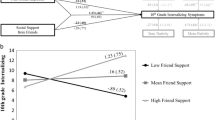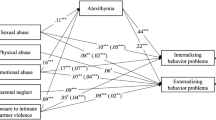Abstract
This purpose of this study was to explore the moderating influence of gender on the relationship between child maltreatment and internalizing symptoms (e.g., affective and somatic problems) and externalizing behavior (e.g., rule breaking behavior and aggression) among children aged 7–12 years old. Using a longitudinal comparison group design and a sample of 300 youth of which 56% (n = 168) had substantiated cases of child maltreatment, results of a structural equation modeling revealed that internalizing symptoms exerted a mediating influence that was conditioned by gender. Only girls’ internalizing symptoms were found to mediate the link between child maltreatment and externalizing behavior while a direct relationship between maltreatment and externalizing behavior was found among boys. These findings provide evidence for gender differences in the pathways between being child maltreatment and maladaptive thoughts, feelings, and behaviors. Thus, adapting evidence-based strategies that target gender specific internalizing behaviors and externalizing behaviors among maltreated youth may significantly reduce the risk of short and long-term maladaptive behavior.

Similar content being viewed by others
References
Achenbach, T. (1991). Manual for the teacher’s report form and 1991 profile. Burlington, VT: University of Vermont, Department of Psychiatry.
Achenbach, T. M., & Rescorla, L. A. (2001). Manual for ASEBA school-age forms & profiles. Burlington, VT: University of Vermont, Research Center for Children, Youth, & Families.
Achenbach, T. M., & Rescorla, L. A. (2007). Multicultural understanding of child and adolescent psychopathology: Implications for mental health assessment. New York: Guilford Press.
Agnew, R. (1985). A revised theory of strain theory of delinquency. Social Forces, 64, 151–167. doi:10.2307/2578977.
Agnew, R. (2001). Building on the foundation of general strain theory: Specifying the types of strain most likely to lead to crime and delinquency. Journal of Research in Crime and Delinquency, 38(4), 319–360. doi:10.1177/0022427801038004001.
Agnew, R., & White, H. R. (1992). An empirical test of general strain theory. Criminology, 30, 475–499. doi:10.1111/j.1745-9125.1992.tb01113.x.
Al-Naser, F., & Sandman, M. M. A. (2000). Evaluating resiliency patterns using the ER89: A case study from Kuwait. Social Behavior and Personality, 28, 505–514. doi:10.2224/sbp.2000.28.5.505.
Aseltine, R. H., Gore, S., & Gordon, J. (2000). Life stress, anger and anxiety, and delinquency: An empirical test of general strain theory. Journal of Health and Social Behavior, 41, 256–275. doi:10.2307/2676320.
Barnett, D., Manly, J. T., & Cicchetti, D. (1993). Defining child maltreatment: The interface between policy and research. In D. Cicchetti & S. L. Toth (Eds.), Child abuse, child development, and social policy (pp. 7–73). Norwood, NJ: Ablex.
Baron, P., & Campbell, T. L. (1993). Gender differences in the depressive symptoms in middle adolescents: An extension of earlier findings. Adolescence, 28, 903–911.
Benda, B. B., & Corwyn, R. F. (2002). The effect of abuse in childhood and adolescence on violence among adolescents. Youth & Society, 33(3), 339–376. doi:10.1177/0044118X02033003001.
Berton, M., & Stabb, D. (1996). Exposure to violence and post-traumatic stress disorder in urban adolescents. Adolescence, 31, 489–499.
Bloom, S. L. (1997). Creating sanctuary: Toward the evolution of sane societies. New York: Routledge.
Boyd-Webb, N. (Ed.). (1999). Play therapy with children in crisis: Individual group, and family treatment. New York: Guilford Press.
Boyd-Webb, N. (2003). Social work practice with children. New York: Guilford Press.
Brezina, T. (1996). Adapting to strain: An examination of delinquent coping responses. Criminology, 34, 39–60. doi:10.1111/j.1745-9125.1996.tb01194.x.
Brezina, T. (1998). Adolescent maltreatment and delinquency: The question of intervening processes. Journal of Research in Crime and Delinquency, 35, 71–99. doi:10.1177/0022427898035001003.
Broidy, L., & Agnew, R. (1997). Gender and crime: A general strain theory perspective. Journal of Research in Crime and Delinquency, 34(3), 275–307. doi:10.1177/0022427897034003001.
Byrne, B. M. (2001). Structural equation modeling with AMOS: Basic concepts, applications, and programming. Mahwah, NJ: Erlbaum.
Chodorow, N. (1978). The reproduction of mothering. Berkeley, CA: University of California Press.
Chodorow, N. (1989). Feminism & psychoanalytic theory. New Haven, CT: Yale University Press.
Cloitre, M., Koenen, K. C., Cohen, L. R., & Han, H. (2002). Skills training in affective and interpersonal regulation followed by exposure: A phase-based treatment for PTSD related to childhood abuse. Journal of Consulting and Clinical Psychology, 70, 1067–1074. doi:10.1037/0022-006X.70.5.1067.
Deblinger, E., & Heflin, A. H. (1996). Treating sexually abused children and their nonoffending parents: A cognitive behavioral approach. Thousand Oaks, CA: Sage Publications.
Deblinger, E., Steer, R. A., & Lippmann, J. (1999). Two-year follow-up study of cognitive behavioral therapy for sexually abused children suffering post-traumatic stress symptoms. Child Abuse & Neglect, 23(12), 1371–1378. doi:10.1016/S0145-2134(99)00091-5.
Delgado, M. (2002). New arenas for community social work practice with urban youth: Use of the arts, humanities, and sports. New York: Columbia University Press.
Dulmus, C. N., & Hilarski, C. (2006). Significance of gender and age in African American children’s response to parental victimization. Health & Social Work, 31(3), 181–188.
Duncan, T. E., Duncan, S. C., Stycker, L. A., Fuzhong, L., & Alpert, A. (1999). An introduction to latent variable growth curve modeling: Concepts, issues, and applications. Mahwah, NJ: Erlbaum.
English, D. J. (2003). The importance of understanding a child’s maltreatment experience cross-sectionally and longitudinally. Child Abuse & Neglect, 27, 877–882. doi:10.1016/S0145-2134(03)00145-5.
Eschenbeck, H., Kohlman, C. W., & Lohaus, A. (2007). Gender differences in coping strategies in children and adolescents. Journal of Individual Differences, 28(1), 18–26. doi:10.1027/1614-0001.28.1.18.
Garmezy, N. (1983). Stressors of childhood. In N. Garmezy & M. Rutter (Eds.), Stress, coping and the development in children (pp. 43–48). New York: McGraw-Hill.
Gerwitz, A. H., & Edelson, J. L. (2007). Young children’s exposure to intimate partner violence: Towards a developmental and risk and resilience framework for research and intervention. Journal of Family Violence, 22, 151–163. doi:10.1007/s10896-007-9065-3.
Greenwald, R. (2002). Trauma and juvenile delinquency: Theory, research, and interventions. Binghamton, NY: The Haworth Maltreatment and Trauma Press.
Hecht, D. B., & Hansen, D. J. (2001). The environment of child maltreatment contextual factors and the development of psychopathology. Aggression and Violent Behavior, 6, 433–457. doi:10.1016/S1359-1789(00)00015-X.
Higgins, D. J., & McCabe, M. P. (2003). Maltreatment and family dysfunction in childhood and the subsequent adjustment of children and adults. Journal of Family Violence, 18(2), 107–120. doi:10.1023/A:1022841215113.
Hindelang, M. (1971). Age, sex, & versatility of delinquent involvements. Social Problems, 18, 522–535. doi:10.1525/sp.1971.18.4.03a00090.
Hindelang, M. (1981). Variations in age–sex–race-specific incidence rates of offending. American Sociological Review, 46, 461–474. doi:10.2307/2095265.
Hoffman, J. P., & Su, S. (1997). The conditional effects of stress on delinquency and drug use: A strain theory assessment of sex differences. Journal of Research in Crime and Delinquency, 34, 46–78. doi:10.1177/0022427897034001004.
Ireland, T. O., Smith, C. A., & Thornberry, T. P. (2002). Developmental issues in the impact of child maltreatment on later delinquency and drug use. Criminology, 40(2), 359–392. doi:10.1111/j.1745-9125.2002.tb00960.x.
Ireland, T., & Widom, C. (1994). Child victimization and risk for alcohol and drug arrest. The International Journal of the Addictions, 29, 122–133.
Jonson-Reid, M. (1998). Youth violence and exposure to violence in childhood: An ecological review. Aggression and Violent Behavior, 3, 159–179. doi:10.1016/S1359-1789(97)00009-8.
Kilpatrick, D. G., Saunders, B. E., & Smith, D. W. (2003). Youth victimization prevalence and implications (pp. 1–14). National Institute of Justice.
Kim, J., & Cicchetti, D. (2003). Social self-efficacy and behavioral problems in maltreated and nonmaltreated children. Journal of Clinical Child and Adolescent Psychology, 32(1), 106–117.
Kim, J., & Cicchetti, D. (2004). A longitudinal study of child maltreatment, mother–child relationship quality, and maladjustment: The role of self-esteem and social competence. Journal of Abnormal Child Psychology, 32(4), 341–354. doi:10.1023/B:JACP.0000030289.17006.5a.
Leadbeater, B. J., Blatt, S. J., & Quinlan, D. M. (1995). Gender-linked vulnerabilities to depressive symptoms, stress, and problem behaviors in adolescents. Journal of Research on Adolescence, 5, 1–29. doi:10.1207/s15327795jra0501_1.
Lemmon, J. H. (1999). How child maltreatment affects dimensions of juvenile delinquency in a cohort of low-income urban youths. Justice Quarterly, 16, 357–376. doi:10.1080/07418829900094171.
Malchiodi, C. A. (1997). Breaking the silence: Art therapy with children from violent homes (Vol. 2). New York: Brunner/Mazel.
Malinosky-Rummell, R., & Hansen, D. J. (1993). Long-term consequences of childhood physical abuse. Psychological Bulletin, 114, 68–79. doi:10.1037/0033-2909.114.1.68.
Margolin, G. (1998). Effects of domestic violence on children. In P. K. Trickett & C. J. Schellenbach (Eds.), Violence against children in the family and the community (pp. 57–102). Washington, DC: American Psychological Association.
Maschi, T. (2006). Trauma and delinquent behavior among males: The moderating role of social support. Stress, Trauma and Crisis: An International Journal, 9(1), 45–72. doi:10.1080/15434610500506233.
Maschi, T., Bradley, C., & Morgen, K. (2008). Unraveling the link between trauma and delinquency: The mediating role of negative affect and delinquent peer exposure. Youth Violence and Juvenile Justice, 6(2), 136–157. doi:10.1177/1541204007305527.
Maughan, A., & Cicchetti, D. (2002). Impact of child maltreatment and interadult violence on children’s emotion regulation abilities and socioemotional adjustment. Child Development, 73(5), 1525–1542. doi:10.1111/1467-8624.00488.
Mazerolle, P. (1998). Gender, general strain, and delinquency: Empirical examination. Justice Quarterly, 15, 65–91. doi:10.1080/07418829800093641.
Mazza, J. J., & Reynolds, W. M. (1999). Exposure to violence in young inner-city adolescents: Relationships with suicidal ideation, depression, and PTSD symptomatology. Journal of Abnormal Child Psychology, 27, 203–213. doi:10.1023/A:1021900423004.
National Data Archive on Child Abuse and Neglect, & Manly, J. T. (2003). An ecological developmental perspective on the consequences of child maltreatment: A user’s guide and codebook. Ithaca, NY: National Data Archive on Child Abuse and Neglect.
Piquero, N. L., & Sealock, M. D. (2000). Generalizing strain theory: An examination of an offending population. Justice Quarterly, 17, 449–484. doi:10.1080/07418820000094631.
Rutter, M. (1981). Stress coping and development: Some issues and some questions. Journal of Child Psychology and Psychiatry and Allied Disciplines, 22, 323–356. doi:10.1111/j.1469-7610.1981.tb00560.x.
Schaffer, C. E. (Ed.). (1993). The therapeutic powers of play. Northvale, NJ: Jason Aronson.
Smith, D. A., & Davidson, L. A. (1986). Interfacing indicators and constructs in criminological research: A note on comparability of self-report violence data for race and sex groups. Criminology, 24(3), 473–489. doi:10.1111/j.1745-9125.1986.tb00386.x.
Smith, C., & Thornberry, T. P. (1995). The relationship between childhood maltreatment and adolescent involvement in delinquency. Criminology, 33, 451–461. doi:10.1111/j.1745-9125.1995.tb01186.x.
Snyder, H. N., & Sickmund, M. (2006). Juvenile arrests 2006. Washington, DC: Office of Juvenile Justice and Delinquency Prevention.
SPSS. (2001a). SPSS for Windows, Rel. 15.0. Chicago: SPSS Inc.
SPSS. (2001b). Amos, Rel. 6.0. Chicago: SPSS Inc.
Stiles, B. L., Liu, X., & Kaplan, H. B. (2000). Relative deprivation and deviant adaptations: The mediating effects of negative self-feelings. Journal of Research in Crime and Delinquency, 37, 64–90. doi:10.1177/0022427800037001003.
U.S. Department of Health and Human Services. (2007). 2005 Child Maltreatment. Washington, DC: Government Printing Office.
Wall, A., & Barth, R. (2005). Aggressive and delinquent behavior of maltreated adolescents: Risk factors and gender differences. Stress, Trauma and Crisis: An International Journal, 8(1), 1–24. doi:10.1080/15434610490888081.
Watts-English, T., Fortson, B. L., Gibler, N., Hooper, S. R., & De Bellis, M. D. (2006). The psychobiology of maltreatment in childhood. The Journal of Social Issues, 62, 717–736. doi:10.1111/j.1540-4560.2006.00484.x.
White, J. W., & Kowalski, R. M. (1998). Male violence against women: An integrative perspective. In R. G. Geen & E. Donnerstein (Eds.), Human aggression: Theory, research and implications for social policy (pp. 203–228). New York: Academic Press.
Widom, C. (1989). Does violence beget violence? A critical examination of the literature. Psychological Bulletin, 106, 3–28. doi:10.1037/0033-2909.106.1.3.
Wodarski, J. S., Kurtz, P. D., Gaudin, J. M., & Howing, P. T. (1990). Maltreatment and the school-age child: major academic, socioemotional, and adaptive outcomes. Social Work, 35, 506–513.
Acknowledgment
The original study was funded by the National Center on Child Abuse and Neglect, U.S. Department of Health and Human Services (Award Number: 90CA1635).
Author information
Authors and Affiliations
Corresponding author
Rights and permissions
About this article
Cite this article
Maschi, T., Morgen, K., Bradley, C. et al. Exploring Gender Differences on Internalizing and Externalizing Behavior Among Maltreated Youth: Implications for Social Work Action. Child Adolesc Soc Work J 25, 531–547 (2008). https://doi.org/10.1007/s10560-008-0139-8
Received:
Accepted:
Published:
Issue Date:
DOI: https://doi.org/10.1007/s10560-008-0139-8




